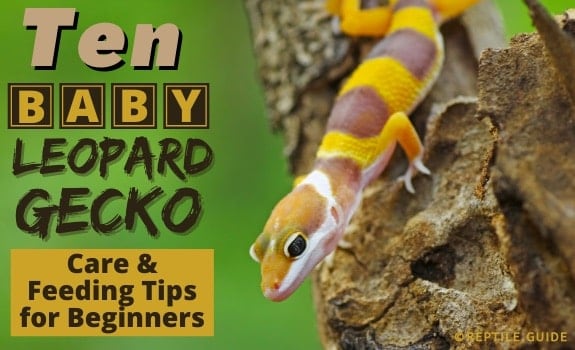Leopard Geckos are one of the most popular pet lizards (opens in new tab) in captivity, and rightfully so.
They have delightful personalities, simplistic husbandry requirements, and irresistibly cute faces! What’s not to love?
Whether you’re the proud new owner of your own Baby Leopard Gecko or you’re trying to learn as much as you can before you pick up or receive your new pet, you’ve come to the right place.
We’re going to cover the ten most important tips for taking care of and feeding your new Baby Leopard Gecko.
Once you nail down these guidelines, there’s not much more to it – just enjoy and bond with your Baby Leopard Gecko!
In This Article
1. Know What to Expect From Your Baby Leopard Gecko
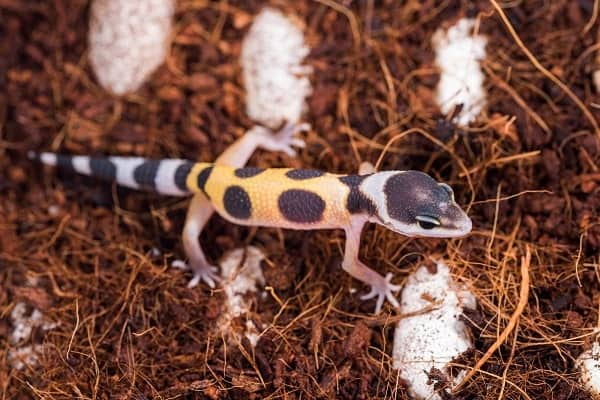
Before we get into any specific care and feeding tips, it’s best to gain a solid understanding of normal and healthy Baby Leopard Gecko behavior!
For example, did you know that new Baby Leopard Geckos probably WON’T eat for the first week while they’re becoming acclimated to their new surroundings?
Or how about the fact that they eat their skin?! That’s right – if you see your Baby Leopard Gecko biting at itself or gulping down some unknown white, papery substance – it’s likely old skin!
Baby Leopard Geckos shed once or twice every week, and you likely won’t find the evidence.
It’s also expected that you may not see your Leopard Gecko move or explore much unless you’re a night owl.
Leopard Geckos are naturally active after the lights go out, and they tend to hide and sleep for most of the day.
Another reality that you should come to terms with is that Baby Leopard Geckos need live insects to grow and thrive.
You can buy the bugs at the pet store, online, or breed them yourself, but the fact of the matter is that you’ll have to be comfortable with having real crickets, grubs, and even roaches in your home on any given day.
Finally, while you may never encounter this freaky phenomenon, it’s essential to be aware of the fact that startled Leopard Geckos will “drop” their tail!
This is a defense mechanism used to distract predators while they make their escape. Don’t worry; most Leopard Geckos recover just fine and even re-grow their tail.
Now that we’ve covered all of the nitty-gritty potential drawbacks of Baby Leopard Gecko ownership, let’s move on to the more positive points:
- They’re so cute! Especially as babies.
- There are several different morphs you can choose from (Albino leopard gecko is one of the most popular ones)
- Leopard Geckos that are handled often seem to enjoy interacting with humans.
- They stay reasonably small and don’t require a huge enclosure.
- Leopard Geckos don’t require expensive, elaborate set-ups or equipment.
- These friendly little guys rarely bite, and even when they do, it doesn’t hurt.
- Leopard Geckos usually go to the bathroom in one corner of their enclosure, making clean-up and maintenance a breeze.
2. Avoid Stressing Out Your Baby Leopard Gecko
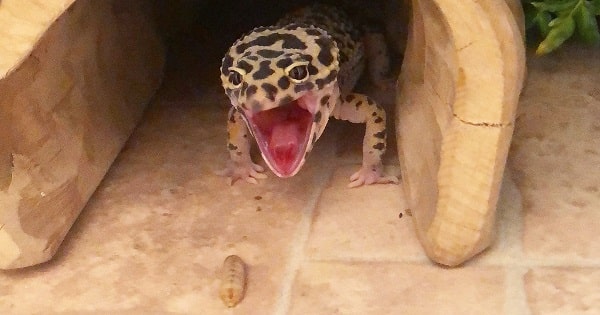
As we mentioned above, when you bring your Baby Leopard Gecko home, it likely won’t eat for the first week or so.
Your Baby Leopard Gecko will be stressed out from the trip and new sights, sounds, and scents.
The best thing to do during this acclimation period is to leave him or her alone. There’s plenty of time for bonding after your baby has settled in!
We suggest you wait to start handling your Baby Leopard Gecko for at least seven days, or until you know it’s eating and pooping fine – whichever criteria takes the longest.
During this time, only open the enclosure to offer fresh water and food (only if it seems to go missing). Try to keep the room somewhat dark and as quiet as possible during this time.
We stress that you should NOT keep adding more bugs every day if they don’t seem to be disappearing. An excessive amount of insect activity in the habitat could stress your baby even more!
When you do start handling your Baby Leopard Gecko, take things slowly. Never try to grab or “catch” your Baby Leopard Gecko if it’s running from you – this could cause it to drop its tail.
While that isn’t a life-threatening situation, you will need to treat the tail base as an open wound, and your Baby Leopard Gecko will need to dedicate its biological resources to regenerating the tail instead of growing.
3. Set Up an Appropriate Enclosure for Your Baby Leopard Gecko
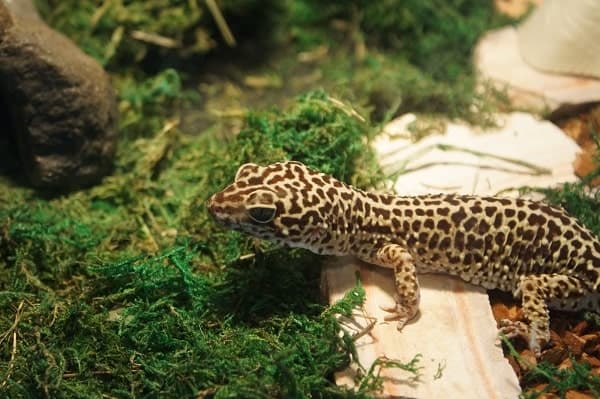
Your Baby Leopard Gecko can start in a small 10-gallon aquarium or a plastic bin with at least 1.25 square feet of floor space.
Inside the enclosure, you should provide:
- At least three hides: one on the warm side, one on the cool side, and one humid hide.
- A shallow water dish that your Baby Leopard Gecko can’t drown in
- Rocks, logs, plants, and aquarium or terrarium decor, as desired.
Once your Baby Leopard Gecko reaches adulthood, it will need an upgrade to an enclosure with at least 2.5 square feet of floor space, like a 20-gallon long aquarium.
You should use a securely-locking lid on your Baby Leopard Gecko’s enclosure.
While they’re terrestrial and can’t climb glass, many crafty young geckos have devised ways to climb corners and terrarium decorations to reach the open top and escape.
Baby Leopard Geckos benefit from UVB lighting, but it’s not required.
If you don’t use a UV bulb over your Leo’s habitat, be sure to supplement their diet with calcium powder that includes Vitamin D3.
If you use lighting, be sure to hook up a timer set for 12 hours on and 12 hours off.
Finally, your Baby Leopard Gecko is going to need supplemental heat to digest its food and stay healthy.
4. Set Up a Temperature Gradient in Your Baby Leopard Gecko’s Enclosure
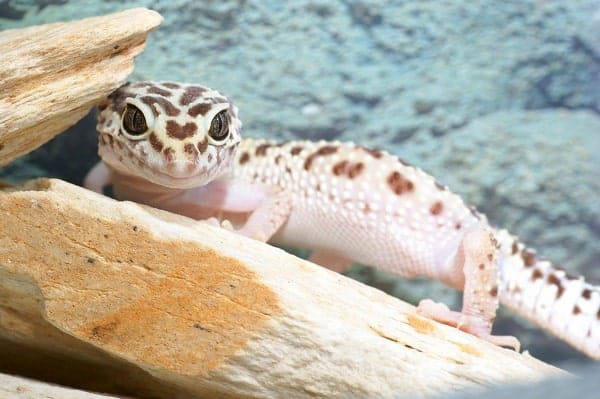
All captive reptiles benefit from a temperature gradient in their enclosure.
Creating a temperature gradient involves heating one side of the enclosure to a maximum ideal temperature; the hottest area on this side of the enclosure is known as the “basking spot.”
The temperature will gradually fall to a minimum ideal temperature on the other side of the enclosure, known as the “cool side.”
The middle of the enclosure should fall somewhere between the maximum and minimum ideal temperatures.
This temperature gradient allows your Leopard Gecko to control its own body temperature by using its environment, which is what ectothermic animals evolved to do.
| Baby Leopard Gecko Temperature Summary | |
|---|---|
| Basking Spot Temperature: | 90-95°F |
| Warm Side Ambient Temperature: | 80-90°F |
| Cool Side Ambient Temperature: | 70-80°F |
| Optional Nighttime Temperature Drop: | 60-74°F |
You can provide heat using any of the following depending on what works best for your set-up:
- Halogen light bulb
- Ceramic heat emitter
- Carbon filament heat projector
- Deep heat projector
- Heating cable
- Heating pad
- Reptile heat tape
Always use a thermostat when operating any heating element to mitigate risks like a house fire or overheating and killing your reptile.
At night, you can likely turn off all heating elements. Research indicates that ectothermic animals benefit from a drop in temperatures at night.
5. Use Safe Substrate in Your Baby Leopard Gecko’s Enclosure
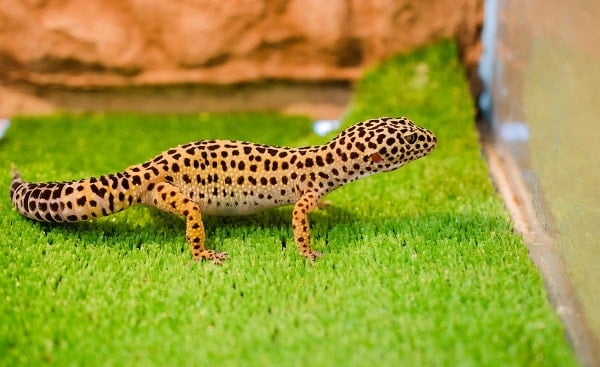
Many new Leopard Gecko owners may be tempted to use “reptile sand” that’s often explicitly marketed for Leopard Geckos.
The scary truth is that most commercially available “reptile sand” is very dangerous for your Baby Leopard Gecko.
Numerous Baby Leopard Geckos have passed away after ingesting too much of their loose substrate while hunting.
Unfortunately, the sand can cause an intestinal blockage, which is a death sentence. Sometimes surgery has been a successful treatment option, but even that comes with its risks.
Most Leopard Gecko veterans recommend these types of substrates to new Baby Leopard Gecko parents:
- Paper towels, non-glossy newspaper, or butcher block paper
- Tile
- Reptile sand mat
- Shelf liner
When your Baby Leopard Gecko grows up, you may want to consider one of the safe particulate substrates available because they are visually appealing and allow your gecko to dig and forage.
Babies are fragile and clumsy and are best kept on a solid substrate until they grow up.
6. Create a Humid Hide for Your Baby Leopard Gecko
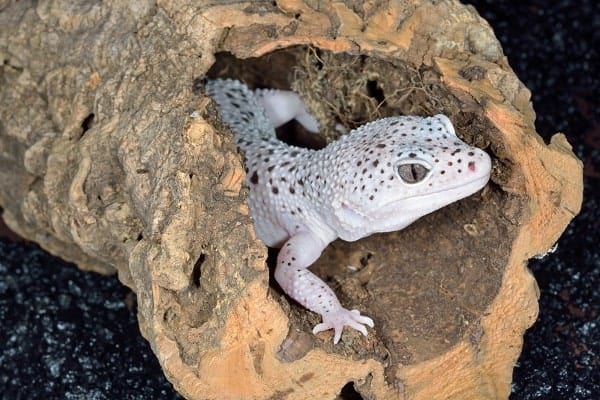
Even though Leopard Geckos are desert-dwelling critters, they need access to a humid hide in captivity to help with shedding.
In the wild, Leopard Geckos are able to create burrow systems that give them access to pockets of high humidity in the ground.
These high-humidity retreats are necessary for healthy hydration levels and shedding processes in Leopard Geckos.
You can replicate this in captivity by filling a hide with damp sphagnum moss or paper towels. Check the media daily for moisture, and add more water as necessary.
Replace the paper or moss if it’s been soiled on or shows any sign of mold growth. Otherwise, replace the medium and clean the hide at least once a month.
Situate the humid hide closer to the warm side of the habitat.
As far as the actual hide, you can use anything from a faux rock cave from the pet store to a Tupperware container with an entry hole cut out.
It needs to be 2 to 3 times the size of your Baby Leopard Gecko’s body. Enclosed hides will hold onto humidity better than bottomless hides.
8. Feed Your Baby Leopard Gecko the Proper Insect Variety
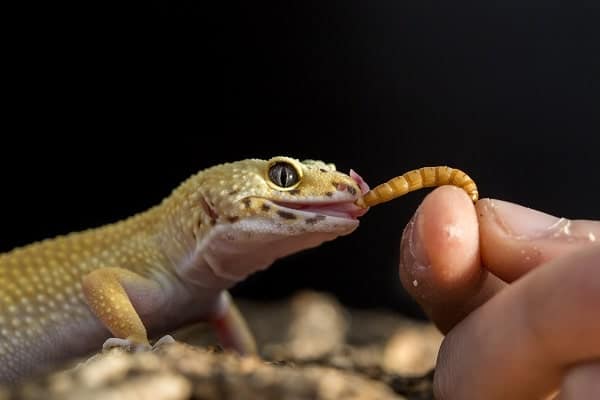
It may seem easier to just stick with one type of insect for your Baby Leopard Gecko’s entire life, but imagine how you would feel if you had to eat the same thing every day!
Feeding your Baby Leopard Gecko a variety of prey items has many benefits, including:
- Mental enrichment from new appearance, scent, movement pattern, taste, and texture.
- Broader coverage of micronutrients. What vitamin one bug may be lacking in, another type may be full of.
- Avoidance of a “picky eater.” What are you going to do if your Leopard Gecko only eats crickets, but there is a cricket shortage?!
Aim to feed a lot of insects that are considered “high-calcium,” such as:
- Black soldier fly larvae
- Earthworms
- Isopods
- Roaches
- Hornworms
- Silkworms
These insects are also suitable as main food items, as long as you gut-load them and coat them with supplemental calcium:
- Crickets
- Mealworms
- Farm-raised grasshoppers
Here are some more commonly-available insects that may be fed as a treat or to help a sick Baby Leopard Gecko gain weight.
- Giant mealworms
- Superworms
- Butterworms
- Waxworms
All of the above are high in fat, so they shouldn’t be offered regularly:
7. Feed Your Baby Leopard Gecko the Proper Insect Size
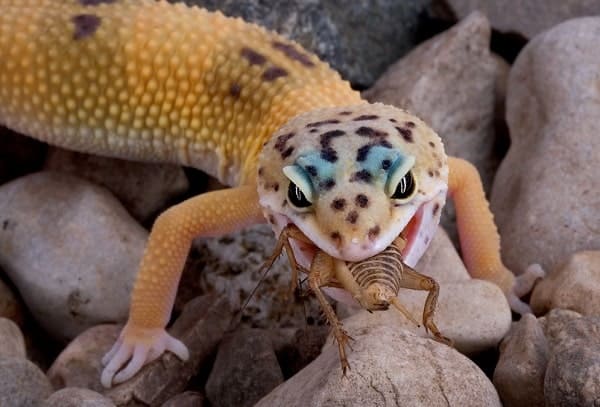
Insects that are too small may not trigger your Baby Leopard Gecko’s hunting instincts whatsoever or may cause your gecko to burn more calories “hunting” than it would gain back by eating the prey.
Insects that are too large can cause swallowing and digestion issues, potentially leading to throat injuries, intestinal impaction, and other problems.
They also may intimidate your Baby Leopard Gecko, and uneaten insects (especially large ones) pose a risk of chewing on your fragile gecko!
The ideal feeder insect size is about as long as your Baby Leopard Gecko’s head or shorter than the distance between its eyes.
Generally speaking, hatchlings will eat ⅜” insects, juveniles will eat ¼” insects, and adult Leopard Geckos will eat ½-¾” insects.
9. Don’t Feed Your Baby Leopard Gecko Too Much OR Too Little
Baby Leopard Geckos should eat every day unless they are stressed or otherwise sick.
The general rule of thumb is to feed one appropriately-sized insect per every inch of your Leopard Gecko’s body, or as many insects as they will eat in 15 minutes.
Baby Leopard Geckos usually don’t become overweight, but if you notice that its tail is getting thicker than its neck, you should cut back on the number of insects you’re offering or switch to an insect with lower fat content.
10. Use Supplements With Your Baby Leopard Gecko’s Food
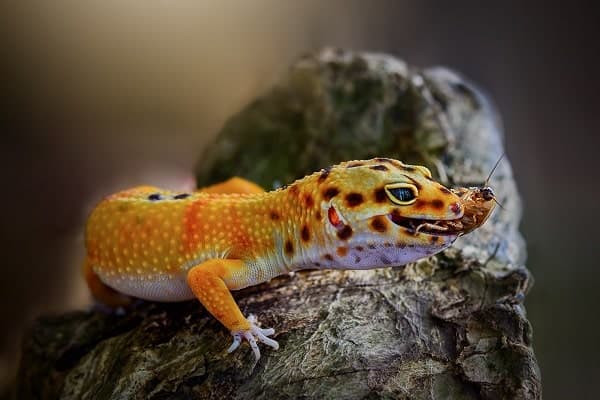
You should dust your Baby Leopard Gecko’s food with supplement powders and gut-load the feeder insects, if possible
You can use commercial high-calcium insect diets or fresh high-calcium vegetables to gut-load:
- Roaches
- Crickets
- Isopods
- Superworms
Most other feeder insects are difficult or impossible to gut-load, so they’ll need a healthy dusting with reptile-safe calcium powder
If you’ve equipped your Baby Leopard Gecko’s habitat with a UVB lighting system, be sure to buy calcium powder without added Vitamin D3.
Follow the manufacturer’s guidelines for replacing the UVB light bulb. They continue to emit light long after the UV-emitting component “dies.”
If your Leopard Gecko doesn’t have access to UV light, buy reptile calcium powder with added Vitamin D3, but less than 25,000 IU/kg.
The amount can be found on the package’s label; it varies drastically from one brand to another.
You should dust all non-gut-loaded feeder insects with calcium powder and add calcium powder to gut-loaded insects every 2nd or 3rd day.
Baby Leopard Geckos also need a reptile multivitamin.
Dust their prey with the multivitamin powder once per week.
Your efforts to provide a balanced diet and proper care will substantially increase your leopard gecko’s lifespan and its quality of life.
Just pick up a new baby leopard gecko but have no idea how to name him/her? Click to see our top 70+ best leopard gecko names here.
